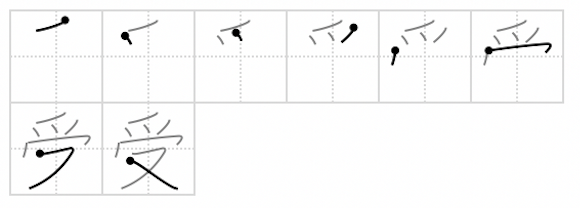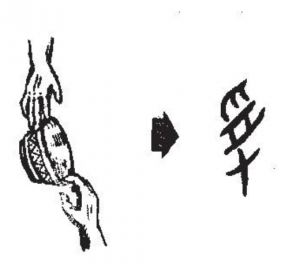Free

- 361 lessons
- 0 quizzes
- 99999 week duration
-
Previous Levels
-
Level 57
-
Level 58
-
Level 59
-
Level 60
-
Level 61
-
Level 62
-
Level 63
-
Level 64
-
Level 65
-
Level 66
-
Level 67
-
Level 68
-
Level 69
-
Level 70
-
Level 71
-
Level 72
-
Level 73
-
Level 74
-
Level 75
-
Level 76
-
Level 77
-
Level 78
-
Level 79
-
Level 80
-
Level 81
-
Level 82
-
Level 83
-
Level 84
-
Level 85
-
Level 86
-
Level 87
-
Level 88
-
Level 89
-
Level 90
-
Level 91
-
Level 92
-
Level 93
-
Level 94
-
Level 95
-
Level 96
-
Level 97
-
Level 98
-
Level 99
-
Level 100
-
Level 101
-
Level 102
-
Level 103
-
Level 104
-
Level 105
-
Level 106
-
Level 107
-
Level 108
-
Level 109
-
Level 110
-
Level 111
-
Level 112
-
Level 113
-
Level 114
-
Level 115
-
Level 116
-
Level 117
-
Level 118
-
Level 119
-
Level 120
-
Level 121
-
Level 122
-
Level 123
-
Level 124
-
Level 125
-
Level 126
-
Level 127
-
Level 128
N3 Kanji 57: 受
Meaning:

In Japanese, 受 means “to receive”.
How to read it:
| Kunyomi | う |
| Onyomi | じゅ |
How to write it:

Origin:

You can see someone received a bowl from another one.
So 受 means “to receive”.

Development:

Vocabulary:
| Word | Reading | Meaning |
|---|---|---|
| 受ける | うける | to receive |
| 受付 | うけつけ | reception |
| 受け取る | うけとる | to receive |
| 受け入れる | うけいれる | to accept |
| 受験 | じゅけん | examination |
| 引き受ける | ひきうける | to undertake |
| 受け止める | うけとめる | to take |
| 受け継ぐ | うけつぐ | to inherit |
| 受信する | じゅしんする | to receive a message |
| 受賞する | じゅしょうする | to receive an award |
| 見受ける | みうける | to see |
| 受容 | じゅよう | acceptance |
| 受け取り | うけとり | acceptance |
| 受け付ける | うけつける | to accept |
| 受診 | じゅしん | consultation |
| 待ち受ける | まちうける | to await |
| 受話 | じゅわ | listening |
| 受話器 | じゅわき | receiver |
| 受け | うけ | popularity |
| 享受 | きょうじゅ | enjoyment |
| 受給 | じゅきゅう | receipt |
| 感受 | かんじゅ | feeling |
| 受講 | じゅこう | attend a lecture |
| 受講料 | じゅこうりょう | tuition fee |
| 受託 | じゅたく | entrustment |
| 受け持つ | うけもつ | to take charge |
| 受精 | じゅせい | fertilization |
| 受け入れ | うけいれ | accepting |
| 受注 | じゅちゅう | receive an order |
| 受動 | じゅどう | passive |
| 受領 | じゅりょう | receipt |
| 受理 | じゅり | acceptance |
| 受け身 | うけみ | passive |
| 引き受け | ひきうけ | undertaking |
| 受かる | うかる | to pass |
| 受け皿 | うけざら | saucer |
| 受諾 | じゅだく | acceptance |
| 受益 | じゅえき | beneficiary |
| 譲り受ける | ゆずりうける | to take over |
| 受け手 | うけて | recipient |
| 受難 | じゅなん | suffering |
| 授受 | じゅじゅ | give and receive |
| 受け合う | うけあう | to undertake |
| 受け答え | うけこたえ | answer |
| 借り受ける | かりうける | to borrow |
| 受け流す | うけながす | to fend off |
| 送受信 | そうじゅしん | send and receive |
| 受け持ち | うけもち | in charge |
| 受け渡し | うけわたし | delivery |
| 甘受 | かんじゅ | acceptance |
| 受胎 | じゅたい | conception |
| 受け売り | うけうり | secondhand |
| 受刑者 | じゅけいしゃ | convict |
| 傍受 | ぼうじゅ | interception |
| 貰い受ける | もらいうける | to get |
| 受章 | じゅしょう | get a decoration |
| 受け渡す | うけわたす | to hand over |
| 軸受け | じくうけ | bearing |
| 拝受 | はいじゅ | receive |
| 受忍 | じゅにん | patience |
| 受け口 | うけぐち | socket |
| 受け狙い | うけねらい | aiming for laughs |
| 収受 | しゅうじゅ | reception |
| 受粉 | じゅふん | pollination |
| 受納 | じゅのう | receipt |
| 受発注 | じゅはっちゅう | receiving orders |
| 受審 | じゅしん | auditee |
| 買い受ける | かいうける | to purchase |
| 受け戻し | うけもどし | redemption |
| 受傷 | じゅしょう | injury |
| 荷受け | にうけ | receipt of goods |
| 借受 | かりうけ | borrowing |
| 前受け | まえうけ | advance received |
| 受水 | じゅすい | receiving water |
| 受贈 | じゅぞう | beneficiary |
| 受検 | じゅけん | examination |
| 受電 | じゅでん | power reception |
| 受認 | じゅにん | acceptance |
| 受発信 | じゅはっしん | outgoing/incoming |
| 受任 | じゅにん | appointment |
| 受配 | じゅはい | receiving of rations |
| 受け払い | うけばらい | payment |
| 発受 | はつじゅ | sending and receiving |
Note:
| The “け” in word “受け付け” is okurigana. The purpose of okurigana is to mark the varied part of a word. This works for verbs. Now, once a verb is turned into a noun, and starts to be recognized as a noun that is independent of the original verb, there is no more purpose to keep the okurigana. That is where the reduction of okurigana happens. So the verb is often written as “受け付けする”, but the noun is often written as “受付”, not “受け付け”. |
Prev
N3 Kanji 56: 取
Next
N3 Kanji 58: 史